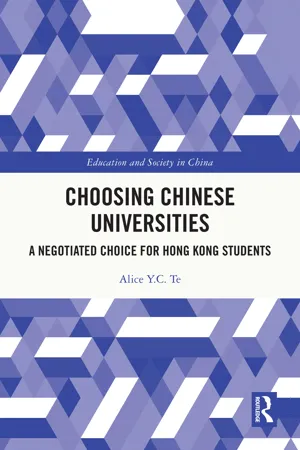
- 216 pages
- English
- ePUB (mobile friendly)
- Available on iOS & Android
About This Book
This book unpacks the complex dynamics of Hong Kong students' choice in pursuing undergraduate education at the universities of Mainland China. Drawing on an empirical study based on interviews with 51 students, this book investigates how macro political/economic factors, institutional influences, parental influence, and students' personal motivations have shaped students' eventual choice of university.
Building on Perna's integrated model of college choice and Lee's push-pull mobility model, this book conceptualizes that students' border crossing from Hong Kong to Mainland China for higher education is a trans-contextualized negotiated choice under the "One Country, Two Systems" principle. The findings reveal that during the decision-making process, influencing factors have conditioned four archetypes of student choice: Pragmatists, Achievers, Averages, and Underachievers. The book closes by proposing an enhanced integrated model of college choice that encompasses both rational motives and sociological factors, and examines the theoretical significance and practical implications of the qualitative study.
With its focus on student choice and experiences of studying in China, this book's research and policy findings will interest researchers, university administrators, school principals, and teachers.
Frequently asked questions
Information
Table of contents
- Cover Page
- Endorsements Page
- Half-Title Page
- Series Page
- Title Page
- Copyright Page
- Dedication Page
- Contents
- List of figures
- List of tables
- Foreword by Ruth Hayhoe
- Acknowledgments
- List of abbreviations
- 1 The changing scene
- 2 Framing the concepts
- 3 Macro contexts under “One Country, Two Systems”
- 4 The pull: Mainland universities' incentivizing admission policies and strategies
- 5 The push: Hong Kong schools' facilitating roles and strategies
- 6 Making a choice: Family and society
- 7 The rationale of making the choice: Four scenarios of student choice
- 8 The process of making the choice: Three phases and the factors of influence
- 9 Making a negotiated choice: Trans-contextualization
- 10 Contributions and conclusion
- Appendix I: Information of interviewees
- Appendix II: Outline of interview questions
- Appendix III: Information of the observations
- Index